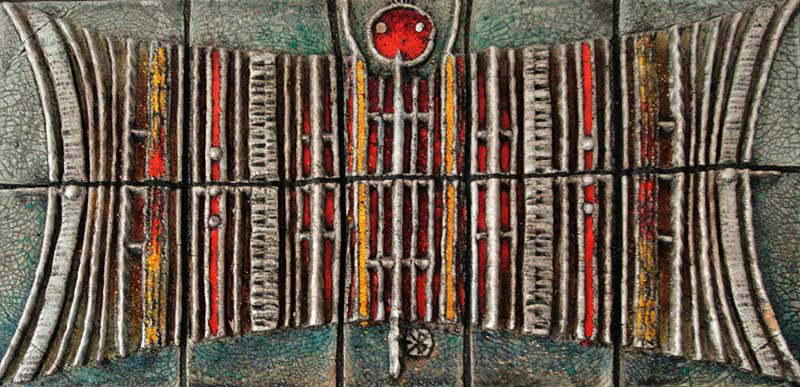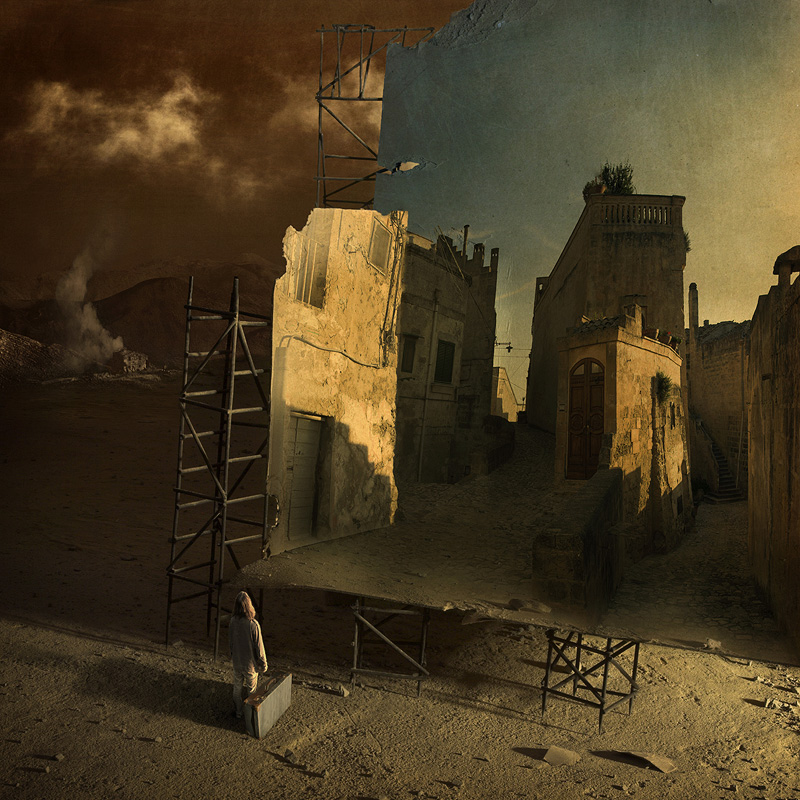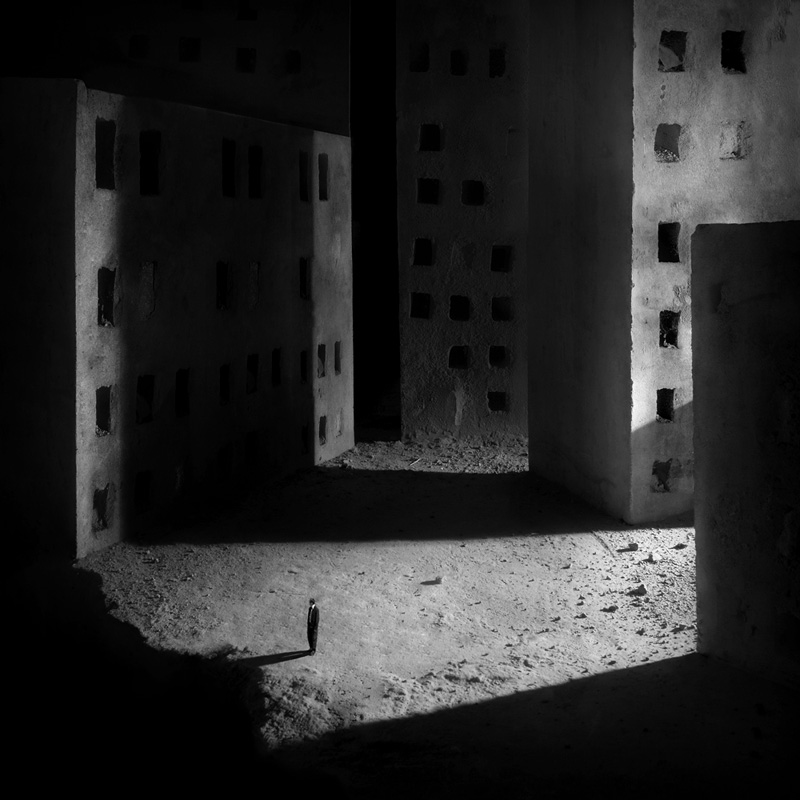
Art & Architecture: Marcin Sacha / interview
The present art world is influenced by continued image-bombing. Where we, as mere spectators, are immersed. Anytime we go through the media searching for what is new or what has been done inside art, we realise that there are more and more flanks, fields and levels where art is continually developing itself. Away from the closed circles of the art market system, the number of amateur artists that rise and take a spot in our visual culture increases every day.
Some of these artists are here just to reconsider the relationship between humanity and the world, emphasizing on the defamiliarization we daily go through with daily realities. These seem to evolve faster than our reasoning or our perception. From this point, Marcin Sacha, an amateur photographer from Tarnow, Poland, shows in his work as a strange world full of this black spots, or ‘gaps’, in the understanding process. Educated as a geophysicist, he turned to Photography in order to show us a world that can be both scarily dangerous and transcendentally beautiful. The process he goes through is to interact with defamiliarized architecture and materials – which he also uses to create graphic effects and illusions of space allow a whole picture to turn into a view of fantasy.
Marcin Sacha’s name might not ring a bell yet, but his breath-taking landscape photographs and his graphic creations are lately taking attention within the Internet web.
Personally, when in front of any picture of Marcin Sacha I feel caught by a sense of nostalgia – nostalgia for to return as the prodigal son; nostalgia for the return to this place we once called ‘ours’ and now it is nothing more than a stage in ruins.
He has taken part in both online and physical exhibitions. Here, he has been awarded several times with gold medals and honour mentions. However, his photographic style has not been consistent during the length of his career. Starting as a landscape photographer, he ended up close to graphic design, always following his theme of ‘creating the space’.
I see no better way to appraise his work than by making this short interview about his career.
Rocío Sola (RS): As a Geophysicist, Photography is a little bit far-fetched from your job, so where do you draw the line between your routine and artistic expression? How exactly did you decide to start with Photography as a way to express yourself?
Marcin Sacha (MS): I grew up in an artistic family. My grandfather was a ceramicist, so I grew up among ceramics, paintings and art books. Nevertheless, I always showed more interest in Science, and with the passage of time, I became a Geophysicist.

I have always felt the need to express myself through art, nonetheless. Images have always spoken to me the most; and as I could not paint, I started to photograph in 2004 – I was already 34 years old then.
At first my photographs leaned more towards about Nature. Landscape photography came afterwards – once I improved my skills. I attempted to create more personal works afterwards, juggling something between photography and graphic design. I know that my profession as a Geophysicist has nothing to do with that.

RS: At first sight, I find a main separation in the topics of your Landscape photographs. We can find both open spaces, and unreal and claustrophobic labyrinths – like these dream-like crazy and absurd architectures typical of dreams and our subconscious.
Is there an evolution from the open fields to the imaginary architectures? or are they rather ways of expressing the same defamiliarization with the object that the viewers (of your photographs) observe?
MS: Indeed. As you said, it is important for me to show known and daily objects in a different light, with a different perspective. I think that it is important to constantly look at the world in a new way, tearing down common schemes or preconceptions. Then, is easier to understand these world we live in, people’s motivations, what touches them and so on…
In my work, Space is the most important thing – experiencing space triggers within me strong emotions. I have always been fascinated by everything associated with the formation of the space. I like architecture, sculpture, big constructions, but also what is related to my profession – influences of geological processes on the shaping of a landscape. I also enjoy travelling, being in motion, and I have an affection to maps.
In the images I use the suspense between: the forms that are filling the space, for building emotions; with all these resources that inform me in a personal way.
RS: Related to this question: Did you find your models and patterns in ‘History of Photography’? or was it more like a personal quest?
MS: Visual culture nowadays is flooded with so many images that we cannot tell when we are being influenced by who. So it is natural to have a compilation of images in our brains. I am not able to give any prototypes of my mock-ups – perhaps I invented them myself; but I started to notice a following.
However, I find artistic inspiration mostly in paintings. I appreciate the mysterious, urban landscapes of Chirico and Sironi. The feeling expressionism found in Munch is also great, and I admire the use of light and shadow, in the building of space and emotions, of Zdzislaw Beksiński’s paintings. I also take inspiration from the (vernacular) architecture of Italian and Spanish small towns – some of my models remind me of it.
RS: I am really interested in this relationship you mention always of the Internet: The separation between the inhabitants of the landscape –or the inhabitants of the city/buildings– and their physical or immediate environment. Is that feeling of scission with something personal? or is it the way you contemplate the actual relationships in general of humans with the World that they are building?
MS: People living in my photographic made-up worlds are usually overwhelmed by the monumental architecture, so they are lost in the space. They feel alienated and lonely. Longing for something else, something undefined… Something on the other side of the stage that seems to be the world perceived by our senses. I would like to convey a certain state of consciousness, that which we often experience before waking up – when we experience that strong emotional reaction associated with this part of the sleep, is when we realize that we are actually dreaming. The dream world is a fiction filled with emotions based on reality; a limbo between two worlds.
Certainly these visions reflect my personal relationship with the world.
RS: In that sense; how would you define your relationship with this vision of the world and the things you photograph?
MS: I consider myself a man who by protecting himself from excessive destructive emotions, unable to cope with the challenges posed by the reality, is running away from the world. There are various forms of escape. This can be an escape into the world of rationality, in the world of art, religion. An evil and suffering find their explanation and even a positive value. Between man and the world, something like a bubble glass is starting to be created. However, there are moments that the bubble fractures and the man comes face to face with the world, which is strange, scary, mysterious but also in its own way beautiful. These moments are accompanied by strong emotions, which I also feel and I would like to build my paintings on them.

RS: Now, about the process;
You claim to also create external elements for your photography structures. Built from paper, clay, ceramics, bricks, etc.. Do you keep all the props that you create, and consider them as individual pieces of art, or are they built ephemerally?
MS: Scenarios are built for the needs of each individual shoot. They are ephemeral.
I use models made of paper, clay or bricks because I like their imperfect surfaces. It is difficult to reproduce the refraction of light on curved materials, or micro-shadows on uneven surfaces, just with purely graphical methods. In these imperfections of natural materials I see beauty.
I also use fragments of others constructions – I photograph close-ups of plaster, rusty metal sheets, structural elements of buildings… A photomontage often consists of several dozens of different images.
RS: How would you describe your shift from landscape to graphic photography?
MS: This transition was a matter of developing my technical skills. In landscape photography I came to a point where I could not say anything more personal, so I felt the need to go a step further.
RS: The last questions will be about your career as a photographer. There are quite a few exhibitions and also you count with an AFIAP distinction. Was it difficult to find yourself in this artistic world as an amateur photographer?
MS: In the world of internet an amateur has and easier path to be seen/known. You can submit your work to contests and exhibitions around the world. No one is asking for the artistic college diploma or professional experience.
When it comes to contact with the language of the world of art it happens to be sometimes difficult for me. As a man who come from the world of science I expect that communication requires the application of the rules of logic. Language of arts world not always have anything in common with that logic, and often consists only of form without meaning.

RS: Which has been the most transcendent exhibition, artists’ encounter or other activity done by you? Do you think that Internet is the most important media for making yourself known?
MS: For me, the possibility of creating is a great experience in itself – that moment when my vision becomes a reality. When my idea gets a tangible shape in the computer screen, after many hours of stacking images in my brain and failed attempts, I feel true joy. This joy comes from the feeling of knowing that all the components of the image are starting to fit together. Becoming something more than a collection of elements. Then, I can tell that the effort I made was really worth it.
In contrast, exhibitions and meetings are primarily a big stress for me.
RS: Which are your expectations in this field of photography?
MS: I would like to further improve my technique, in order to get even more ease when turning my visions to reality. Maybe then I can go for the next step: from Photography towards Pure Graphics.
RS: Where do you see yourself in ten years?
MS: I do not know what I will be thinking, who I will be, and what I will be doing in ten years. This world keeps changing very fast.
RS: Thank you very much. This has been a very interesting exchange of words and arguments. I wish you the best in this road of self-evolving and self-developing.
Text by: Rocío Sola and Marcin Sacha / Images: Marcin Sacha’s work & Ceramic by Bolesław Książek / English edition: Jane Horcajo Originally written for AAAA magazine / Date: 19 jan 2017
